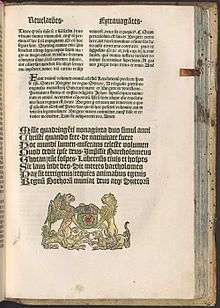colophon
English

The last page of the 1492 work Revelationes caelestes: mit Vita abbreviata sanctae Birgittae (Celestial Revelations: With a Short Life of Saint Bridget), which features a colophon and a printer's mark
Etymology
Borrowed from Ancient Greek κολοφών (kolophṓn, “peak or finishing touch”).
Pronunciation
- (UK) IPA(key): /ˈkɒləfən/
Noun
colophon (plural colophons)
- In manuscripts (typically before the invention of printing), the note, usually at the end, left by the scribe who copied it, giving information on his exemplar, where and when the copy was made, and sometimes, his own name.
- (printing) A printer's or publisher's identifying inscription or logo appearing at the front or end of a book, or the same appearing on the spine or dust-jacket. It generally contains factual information about the book, especially about its production, and includes details about typographic style, the fonts used, the paper used, and perhaps the binding method of the book. Also used in a similar fashion for newspapers, magazines, and academic journals.
- (Internet) A page on a website identifying the details of its creation, such as the author's name and the technologies used.
- (obsolete) A finishing stroke or crowning touch.[1]
- 1635, John Swan, Speculum Mundi, page 427
- He comes to the creation of man, and makes him the Colophon, or conclusion of all things else.
- 1635, John Swan, Speculum Mundi, page 427
Translations
end note about author and manuscript
French
Etymology
Borrowed from Ancient Greek κολοφών (kolophṓn, “peak or finishing touch”).
Pronunciation
- IPA(key): /kɔ.lɔ.fɔ̃/
Noun
colophon m (plural colophons)
- colophon, final notice on manuscript.
- colophon, final notice about printer, editor, paper, etc., with bibliophilic information.
Further reading
- “colophon” in le Trésor de la langue française informatisé (The Digitized Treasury of the French Language).
This article is issued from
Wiktionary.
The text is licensed under Creative
Commons - Attribution - Sharealike.
Additional terms may apply for the media files.